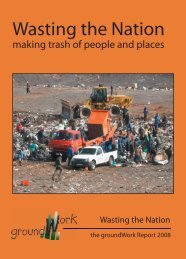Incinerators in Disguise - GAIA
Incinerators in Disguise - GAIA
Incinerators in Disguise - GAIA
You also want an ePaper? Increase the reach of your titles
YUMPU automatically turns print PDFs into web optimized ePapers that Google loves.
<strong>Inc<strong>in</strong>erators</strong> In <strong>Disguise</strong>: Case Studies 12<br />
Brightstar Environmental / Energy Developments Limited<br />
Name of Facility: Brightstar Environmental<br />
Owner: Brightstar Environmental (former website:<br />
www.brightstarenvironmental.com) was a subsidiary of Energy<br />
Developments Limited (www.energydevelopments.com). Energy<br />
Developments is no longer pursu<strong>in</strong>g SWERF (Solid Waste & Energy<br />
Recycl<strong>in</strong>g Facility) technology. Brightstar Environmental is no longer <strong>in</strong><br />
operation. 1<br />
Location: Wollongong, New South Wales, Australia<br />
Technology: Gasification followed by combustion of gases and oils (pre-process<strong>in</strong>g<br />
<strong>in</strong>cluded autoclav<strong>in</strong>g) for municipal solid waste<br />
Status: Closed <strong>in</strong> April 2004. Commercial-scale facility operated <strong>in</strong> test phase from<br />
2000 to 2004.<br />
Brightstar Environmental’s gasification technology was called the Solid Waste & Energy Recycl<strong>in</strong>g<br />
Facility, or SWERF. Although both Brightstar Environmental and its parent company Energy<br />
Developments Limited aggressively promoted the SWERF technology <strong>in</strong> many countries, only one<br />
facility was ever constructed. The facility was designed to dispose of 30,000 tons of municipal waste<br />
per year, and the company planned to expand <strong>in</strong> order to dispose of 150,000 tons per year. 2 By the<br />
time Energy Developments decided to close the facility, it had lost at least Au$175 million (US$134<br />
million) on SWERF. 3<br />
Brightstar Environmental <strong>in</strong>tended to operate as a commercial facility and had a process<strong>in</strong>g<br />
agreement with the city of Wollongong, but repeated technical problems prevented the technology<br />
from mov<strong>in</strong>g out of test phase. After two years of test operations, an Energy Developments press<br />
release stated that “a run of 50 hours [has] been achieved ” but that the facility was hav<strong>in</strong>g problems<br />
with “m<strong>in</strong>or material handl<strong>in</strong>g issues.” 4<br />
The SWERF technology had additional technical problems with the follow<strong>in</strong>g components:<br />
• Replacement of second gasification unit for char (solid residues) 5<br />
• High levels of f<strong>in</strong>e particles <strong>in</strong> the char gasification unit 6<br />
• Gasifier feed<strong>in</strong>g system 7<br />
• Preprocess<strong>in</strong>g dry<strong>in</strong>g system 8<br />
Emissions tests <strong>in</strong> 2001 observed the follow<strong>in</strong>g problems: result for sulfuric acid mist and/or sulfur<br />
trioxide was found at nearly twice the allowable limit <strong>in</strong> the facility’s permit 9 ; arsenic exceeded the<br />
limit <strong>in</strong> the facilities permit 10 ; NO x emissions were high (tests showed 190-300 mg/m³; as a<br />
comparison, the German NO x limit is 200 mg/Nm³), 11 and carbon monoxide emissions were very<br />
high (tests showed 681 mg/m³; as a comparison the German CO limit is 50 mg/Nm³). 12 The same<br />
tests found emissions of diox<strong>in</strong>, hydrogen chloride, hydrogen fluoride, polyaromatic hydrocarbons,

















